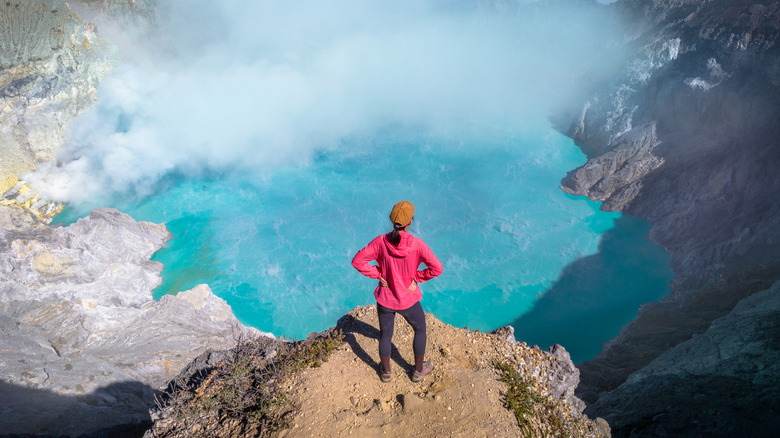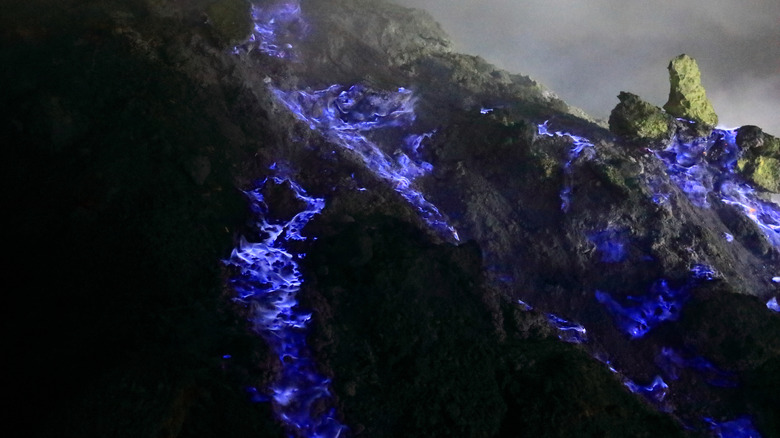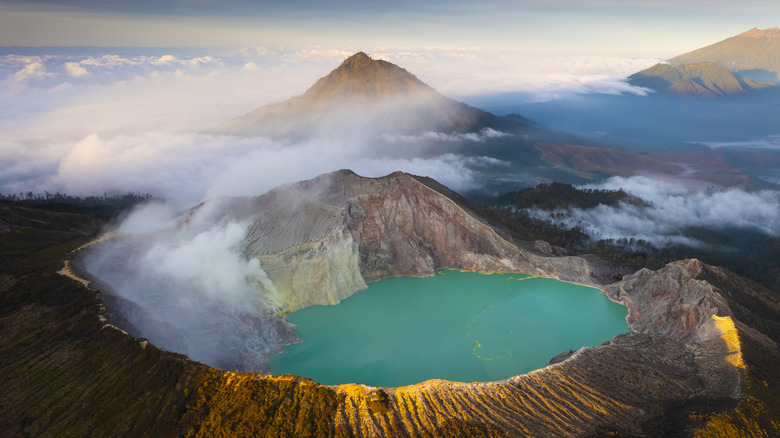Indonesia's 'Gates Of Hell' Volcano Is An Overnight Trip From Bali With Blue Flames And Otherworldly Views
It takes a certain kind of traveler to hear "Gates of Hell" and instantly start planning an itinerary. For the adventurous at heart, scaling the rugged slopes of Mount Ijen is a once-in-a-lifetime experience. Situated in East Java, Indonesia, this active volcano is referred to by many names, including Ijen Crater and Kawah Ijen. However, its claim to fame is the bright turquoise sulfuric lake steeping in the crater, constantly steaming and bordered by electric blue flames.
Like Europe's tallest active volcano, Mount Etna, Mount Ijen is no sleeping giant. However, instead of steadily leaking lava, it releases sulfur gas. As the gases seep from crevices deep in the crater, they catch fire, resulting in otherworldly blue flames flickering around an eerily still pool, the most acidic lake in the world. Adding to the surreal scene, Mount Ijen is a working sulfur mine. In the pre-dawn darkness, workers haul baskets of yellow sulfur chunks — weighing up to 200 pounds — from the crater's depths, loading their spoils into metal wheelbarrows for the trip down the mountain. Combined with long-dead trees clinging to the crater's edge and rugged volcanic rocks, it's easy to compare Mount Ijen to a hellscape.
To reach the edge of the crater lake, you'll need to hike 3 miles (one-way) along a steep, rock-strewn path. Although technically a guide isn't required, it's highly recommended. Local guides are familiar with the terrain and will arrange all the bothersome details, including entry tickets, transportation, and altering itineraries depending on the conditions.
How to reach Mount Ijen's Gates of Hell
The best jumping-off point for exploring Mount Ijen is Banyuwangi, in East Java. Situated about 1.5 hours from the trailhead, this coastal city has plenty of affordable hotels, restaurants, and tourist-friendly services. There are numerous tour operators, but Ijen BlueFlame Tours receives consistently high praise and offers multi-destination packages from Banyuwangi that make the trip to Java worth it.
Those coming from Bali can turn Ijen into a very long one-day trip, but your "Gates of Hell" adventure is best approached as an overnight excursion. After taking the 35-minute ferry ride from West Bali's Gilimanuk Port to Banyuwangi's Ketapang Port, check into your hotel and get some sleep. At around 12:30 a.m. or 1 a.m., your guide will pick you up and drive to the trailhead. Here, you can buy souvenirs, use the bathroom, and warm up with a cup of instant coffee or ramen. It's also the last place to buy water, in case you forgot your bottle.
Before arranging the tour, you need to decide if seeing the blue flames is a priority or if witnessing sunrise over the sulfur lake will be enough. Blue fire chasers should start hiking by 1 a.m., as the flames are less visible when even the first flickers of dawn light up the horizon. There's also no guarantee that you'll see the flames, and you need to hike an extra 45 minutes down a hazardous trail into the crater for the best views of this natural phenomenon.
Tips for hiking Mount Ijen
The best time to hike up Mount Ijen is during the dry season (July to September), when downpours are less likely and the blue flames are larger. Regardless of the time of year, you'll need to pack sturdy boots that protect your feet and ankles from sharp rocks — sandals are not a good idea, and if you need to get new footwear, only buy hiking shoes at this time of day to get the best fit. The temperature on the summit can drop to 32 degrees Fahrenheit, so make sure to dress in layers, including a jacket, knit hat, and long pants or leggings. Additional must-pack items include a flashlight, sunscreen, water, and lightweight snacks.
Usually, your guide will provide a gas mask to protect you from sulphur dioxide and hydrogen sulphide. Make sure to wear the mask if you hike into the crater or when breezes on the summit blow volcanic gas into your face. The sunrise reveals the sheer magnitude of the impressive crater, and you'll want to safely savor every moment.
Although Java is a stunning Indonesian island that's similar to Bali without over-tourism, Mount Ijen often gets crowded, specifically on holidays (Indonesian or international) and weekends. Even with noxious gases seeping from the crater, arguably the greatest threat to your safety is other visitors not being aware of their bodies or surroundings. Always proceed with caution and prioritize safety over getting an amazing photo or being the first at the sunrise point.


